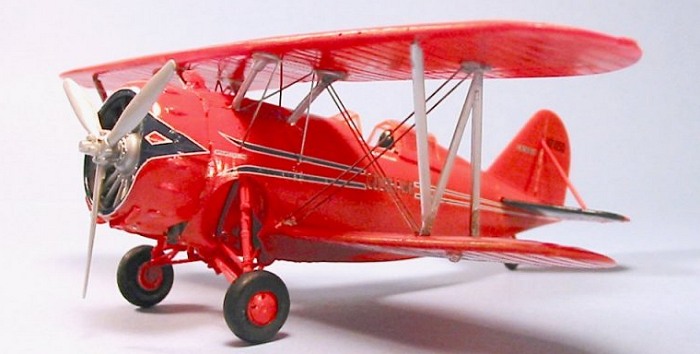
| KIT #: | ? |
| PRICE: | $44.95 MSRP |
| DECALS: | One option |
| REVIEWER: | Tom Cleaver |
| NOTES: | Long out of production, but you can still find them. |

| HISTORY |
When I was but a wee aeronut, my dad used to take me to air shows. I vividly remember 1955, when I got to see both the Blue Angels in their last year in F9F-5 Panthers and the Thunderbirds in their last year in F-84G Thunderjets. I also remember my father telling me about an air show performer I’d never get to see, who had put on shows that no one else could do. The performer was Major Al Williams and his airplane was the Gulfhawk II. I also recall that shortly thereafter Model Airplane News published an issue with one of those great paintings they had for their covers, this one of the Gulfhawk. I had that taped on the wall of my bedroom for many years, until it finally fell apart. I also built the Monogram 1/32 Gulfhawk that came out way back then.
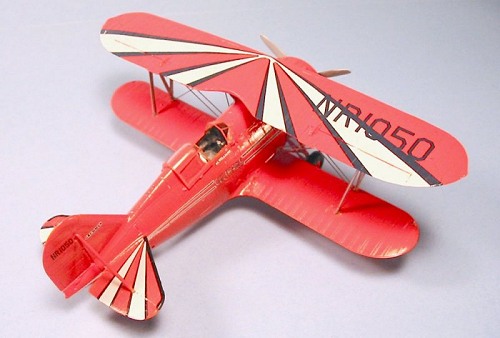 The Gulfhawk II was
known to Grumman as the G-22, and was built to the specifications of Al
Williams, who represented the Gulf Oil Company with his spectacular flying
displays. It became the most famous of all the Grumman biplanes, flying in
hundreds of air shows between 1936 and 1948, when it was retired to the
Smithsonian Institution, where it can be seen today.
The Gulfhawk II was
known to Grumman as the G-22, and was built to the specifications of Al
Williams, who represented the Gulf Oil Company with his spectacular flying
displays. It became the most famous of all the Grumman biplanes, flying in
hundreds of air shows between 1936 and 1948, when it was retired to the
Smithsonian Institution, where it can be seen today.
The Gulfhawk was a very highly modified development of the F3F series. It differed by having the shorter-span wings of the F2F-1 - which improved roll rate in aerobatics and gave increased speed - and was powered by a special 1,000 h.p. Wright R-1820-G-1 Cyclone engine with modified oil and fuel systems that allowed up to 30 continuous minutes of inverted flight, as well has having a modified, tighter cowling. With no military equipment, the G-22 was 400 pounds lighter than the F3F-2. The result was an airplane with a top speed of 290 mph, 34 mph faster than a production F3F-2.
When not performing at air shows, Gulf Oil used the Gulfhawk as a flying test bed for new fuels, oils and lubricants, and new equipment designed by Williams.
The Gulfhawk was shipped to England in 1938 for the Gatwick Air Show, which was followed by a tour of Holland, France and Germany, where Ernst Udet became the only other person to fly it, permitting Williams to become the first American to fly a Bf-109.
In 1943, Williams made a tour of Army Air Forces training bases, putting on shows to inspire the aviation cadets.
The Gulfhawk II retired on October 11, 1948, when Williams flew it to National Airport in Washington D.C. and handed it over to the Smithsonian, after which he took possession of his last Gulfhawk, a modified F8F-1 known as the Gulfhawk IV. (Editor's Note: There was also a Gulfhawk III. It was a two seater that didn’t last long. During the war it was donated by Gulf to the Army Air Force to be used as a training plane. The fact was Al didn’t care to be a “driver” in a two seater and take passengers for rides. After the war it ultimately crashed in a Florida swamp. Thanks to reader Joseph Williams, Al Williams nephew, for the information.)
| THE KIT |
When Bill Bosworth told me in 2000 that Accurate Miniatures was going to release a kit of the Gulfhawk II as part of their F3F series, I was ready to get one as soon as they became available, and did so.
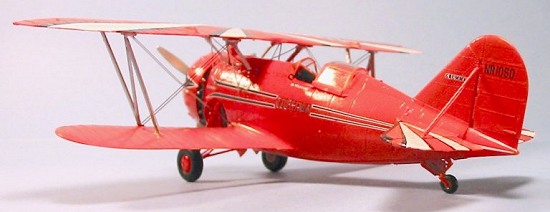 The kit came with
resin wings, cowling and forward upper fuselage, cast by Black Box. It
also included a container of Humbrol acrylic orange paint that Bill’s
research had determined was the correct color. Full markings decals were
by MicroScale.
The kit came with
resin wings, cowling and forward upper fuselage, cast by Black Box. It
also included a container of Humbrol acrylic orange paint that Bill’s
research had determined was the correct color. Full markings decals were
by MicroScale.
I have to sadly report that the kit was underwhelming. I wondered if perhaps it was me, but several other modelers who bought the kit reported similar experiences.
The resin casting was not the best. The wings were not particularly smooth, and the upper wing had a warp that gave it anhedral; despite four attempts to de-warp the wing by dipping it in hot water, the warp was persistent, which means it was designed in to the mold. To top that off, the forward upper fuselage part had its molding block attached to the side, making it virtually impossible to get a good fit of the part to the plastic fuselage without a lot of C-A glue, putty and Mr. Surfacer. Because the wings were shorter, the photoetch wire bracing had to be cut, which resulted in difficulty getting good alignment of these wires.
However, from a distance of a couple feet the model looked nice, and
non-modelers have never noticed any of these defects since I gave the model
to my friend Mark F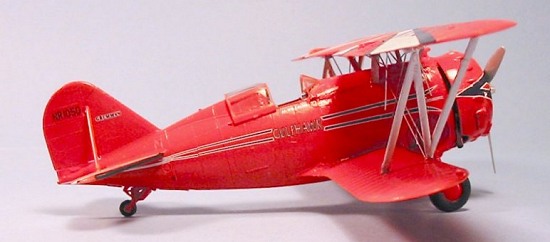 oster
at Planes of Fame (whose e-mail handle is “Gulfhawk” because it’s his
favorite airplane) and he displayed it on the shelf behind his desk.
oster
at Planes of Fame (whose e-mail handle is “Gulfhawk” because it’s his
favorite airplane) and he displayed it on the shelf behind his desk.
Then last year, I happened to look at the two Gulfhawk kits that had been gathering dust at my local shop (word had gotten around), and happened to notice that one of them had a sticker that the resin casting was by Roy Sutherland. Given Roy’s reputation as a master resin caster, this one would have to be better.
But, as someone important once said, “fool me once, shame on me - fool me twice...you fooled me.”
| CONSTRUCTION |
The unfortunate news about the kit is that for whatever reasons (I suspect
lack of funds) Roy was not allowed to make new masters. Given his talent,
I am sure the kit would have been completely hassle-free had this
happened. Thus, while the parts themselves are in fact better-cast, they
are still the parts that were defective in basic production design,
including that 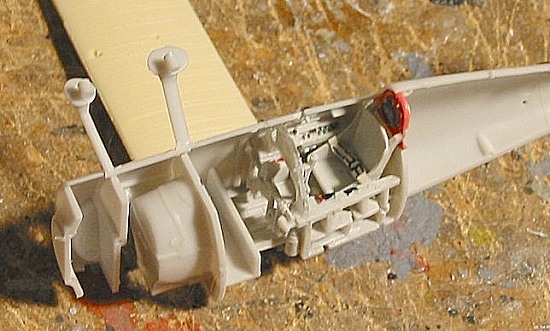 persistent
anhedral in the upper wing.
persistent
anhedral in the upper wing.
This time, I didn’t even bother with the upper fuselage part. I filled in the gun troughs of the injection-molded kit part with cyanoacrylate, covered that with Mr. Surfacer, and sanded it smooth.
Fortunately, the essential design of the F3F kits is very good, and the model goes together easily. The instructions provide all the information the modeler needs to create a Gulfhawk - painting the cockpit overall light grey, etc.
Getting the cowling to go around the engine is a bit iffy, because the rear of the cowl is a gentle oval and narrower on the side than the engine is wide. Thus, you have to squeeze it ever so carefully, holding your breath that you don’t squeeze too much and end up breaking the one-and-only cowling that cannot be replaced. Once that was on, all was well.
| COLORS & MARKINGS |
Since the model is overall orange, I had assembled the landing gear with the fuselage sub-assembly. The entire airframe other than the interplane “N” struts was painted with the kit paint and set aside to dry. The “N” struts were painted with Alclad II “Polished Aluminum” after being primed with the correct Alclad primer. The prop was also painted with Alclad.
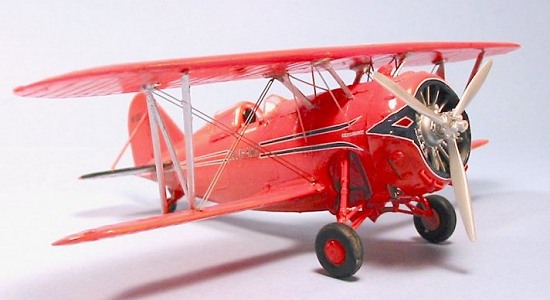 The decals are
thin, and it is easy to screw up the smaller decals if they are not applied
carefully. I used a lot of water on the model surface to move the decal
into place. I only applied decal setting solution after I had blotted the
water from the decal after insuring its proper location.
The decals are
thin, and it is easy to screw up the smaller decals if they are not applied
carefully. I used a lot of water on the model surface to move the decal
into place. I only applied decal setting solution after I had blotted the
water from the decal after insuring its proper location.
| FINAL CONSTRUCTION |
The upper wing of the model goes on as easily as do the upper wings of the standard F3F kits. Unfortunately, that anhedral in the wing ends up pushing the lower wings down just a bit, enough that close examination reveals unavoidable “wing droop.” If you don’t look at the model head on or from directly astern, it’s not that noticeable.
Since the Gulfhawk II was maintained in immaculate condition, I added no weathering.
I clipped the photoetch rigging at the outer end and with care was able to attach it with proper alignment.
| CONCLUSIONS |
There’s no getting around the fact that the kit is a disappointment, due to the original poor design of the masters for the resin parts. If anyone has managed to find a way to de-warp the upper wing or get rid of the “wavy surface” of both upper and lower wings, I’d love to hear about it.
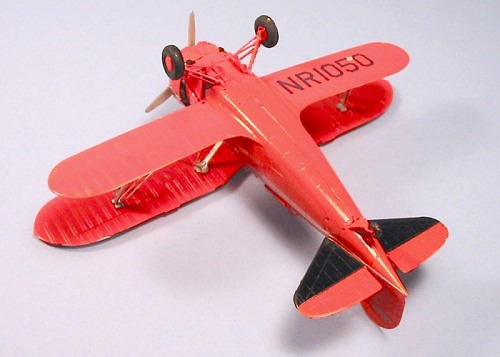 That said, the
likelihood of another accurate Gulfhawk II being produced by anyone is
right up there with the probability of the sun rising in the west. The kit
is buildable, particularly if you toss that upper fuselage resin part and
convert the kit part. From a distance of a couple feet, the problems
inherent in the model are not that noticeable. It’s still the coolest
civilian biplane ever.
That said, the
likelihood of another accurate Gulfhawk II being produced by anyone is
right up there with the probability of the sun rising in the west. The kit
is buildable, particularly if you toss that upper fuselage resin part and
convert the kit part. From a distance of a couple feet, the problems
inherent in the model are not that noticeable. It’s still the coolest
civilian biplane ever.
And the Monogram 1/32 kit, assuming you could find it from a kit collector at a price that didn’t involve renegotiating the national debt, is completely inaccurate since it is the F3F-2 without any modification to the wings or cowling.
I am sure you can find these kits at shows if you look around. There is also the possibility of finding one sitting way back on the rear shelf gathering dust, if you are still fortunate enough to have access to an “old fashioned” hobby shop. If you find it, it’s worth picking up.
June 2005
Kit courtesy of my wallet.
If you would like your product reviewed fairly and fairly quickly, please contact the editor or see other details in the Note to Contributors.